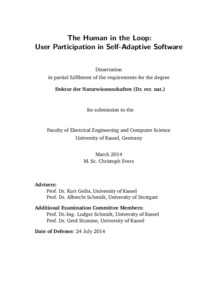| dc.date.accessioned | 2014-08-13T07:51:35Z | |
| dc.date.available | 2014-08-13T07:51:35Z | |
| dc.date.issued | 2014-08-13 | |
| dc.identifier.uri | urn:nbn:de:hebis:34-2014081345873 | |
| dc.identifier.uri | http://hdl.handle.net/123456789/2014081345873 | |
| dc.language.iso | eng | |
| dc.rights | Urheberrechtlich geschützt | |
| dc.rights.uri | https://rightsstatements.org/page/InC/1.0/ | |
| dc.subject | Software Engineering | eng |
| dc.subject | Adaptive Systeme | ger |
| dc.subject | Ubiquitous Computing | eng |
| dc.subject | Gebrauchstauglichkeit | ger |
| dc.subject.ddc | 004 | |
| dc.title | The Human in the Loop: User Participation in Self-Adaptive Software | eng |
| dc.type | Dissertation | |
| dcterms.abstract | Self-adaptive software provides a profound solution for adapting applications to changing contexts in dynamic and heterogeneous environments. Having emerged from Autonomic Computing, it incorporates fully autonomous decision making based on predefined structural and behavioural models. The most common approach for architectural runtime adaptation is the MAPE-K adaptation loop implementing an external adaptation manager without manual user control. However, it has turned out that adaptation behaviour lacks acceptance if it does not correspond to a user’s expectations – particularly for Ubiquitous Computing scenarios with user interaction. Adaptations can be irritating and distracting if they are not appropriate for a certain situation. In general, uncertainty during development and at run-time causes problems with users being outside the adaptation loop. In a literature study, we analyse publications about self-adaptive software research. The results show a discrepancy between the motivated application domains, the maturity of examples, and the quality of evaluations on the one hand and the provided solutions on the other hand. Only few publications analysed the impact of their work on the user, but many employ user-oriented examples for motivation and demonstration. To incorporate the user within the adaptation loop and to deal with uncertainty, our proposed solutions enable user participation for interactive selfadaptive software while at the same time maintaining the benefits of intelligent autonomous behaviour. We define three dimensions of user participation, namely temporal, behavioural, and structural user participation. This dissertation contributes solutions for user participation in the temporal and behavioural dimension. The temporal dimension addresses the moment of adaptation which is classically determined by the self-adaptive system. We provide mechanisms allowing users to influence or to define the moment of adaptation. With our solution, users can have full control over the moment of adaptation or the self-adaptive software considers the user’s situation more appropriately. The behavioural dimension addresses the actual adaptation logic and the resulting run-time behaviour. Application behaviour is established during development and does not necessarily match the run-time expectations. Our contributions are three distinct solutions which allow users to make changes to the application’s runtime behaviour: dynamic utility functions, fuzzy-based reasoning, and learning-based reasoning. The foundation of our work is a notification and feedback solution that improves intelligibility and controllability of self-adaptive applications by implementing a bi-directional communication between self-adaptive software and the user. The different mechanisms from the temporal and behavioural participation dimension require the notification and feedback solution to inform users on adaptation actions and to provide a mechanism to influence adaptations. Case studies show the feasibility of the developed solutions. Moreover, an extensive user study with 62 participants was conducted to evaluate the impact of notifications before and after adaptations. Although the study revealed that there is no preference for a particular notification design, participants clearly appreciated intelligibility and controllability over autonomous adaptations. | eng |
| dcterms.accessRights | open access | |
| dcterms.creator | Evers, Christoph | |
| dc.contributor.corporatename | Kassel, Universität, FB 16, Elektrotechnik / Informatik | |
| dc.contributor.referee | Geihs, Kurt (Prof. Dr.) | |
| dc.contributor.referee | Schmidt, Albrecht (Prof. Dr.) | |
| dc.contributor.referee | Schmidt, Ludger (Prof. Dr.) | |
| dc.contributor.referee | Stumme, Gerd (Prof. Dr.) | |
| dc.subject.ccs | C.2.4 | |
| dc.subject.ccs | I.2.2 | |
| dc.subject.ccs | D.2.1 | |
| dc.subject.ccs | D.2.2 | |
| dc.subject.ccs | H.1.2 | |
| dc.subject.ccs | H.3.4 | |
| dc.subject.ccs | I.2.6 | |
| dc.subject.ccs | I.2.8 | |
| dc.subject.ccs | I.2.3 | |
| dc.subject.msc | 93C85 | ger |
| dc.subject.msc | 68T05 | ger |
| dc.subject.msc | 93C42 | ger |
| dc.subject.msc | 68T37 | ger |
| dc.subject.msc | 68M14 | ger |
| dc.subject.msc | 68N01 | ger |
| dc.subject.swd | Software engineering | ger |
| dc.subject.swd | Adaptive Systeme | ger |
| dc.subject.swd | Ubiquitous Computing | ger |
| dc.subject.swd | Funktionalität | ger |
| dc.date.examination | 2014-07-24 | |

